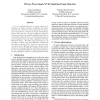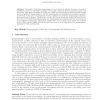164 search results - page 23 / 33 » Covert two-party computation |
EUROCRYPT
2009
Springer
14 years 10 months ago
2009
Springer
We consider information-theoretic key agreement between two parties sharing somewhat different versions of a secret w that has relatively little entropy. Such key agreement, also ...
COMSWARE
2008
IEEE
14 years 4 months ago
2008
IEEE
—Presence technology is going to be an integral part of the next generation of communication technology. It can eliminate telephone tag between two parties (caller and callee), w...
ICDM
2007
IEEE
14 years 4 months ago
2007
IEEE
It is not surprising that there is strong interest in kNN queries to enable clustering, classification and outlierdetection tasks. However, previous approaches to privacypreservi...
EUROCRYPT
2004
Springer
14 years 3 months ago
2004
Springer
Informally, a public-key steganography protocol allows two parties, who have never met or exchanged a secret, to send hidden messages over a public channel so that an adversary can...
CONCUR
2003
Springer
14 years 3 months ago
2003
Springer
Abstract. A contract signing protocol lets two parties exchange digital signatures on a pre-agreed text. Optimistic contract signing protocols enable the signers to do so without i...


